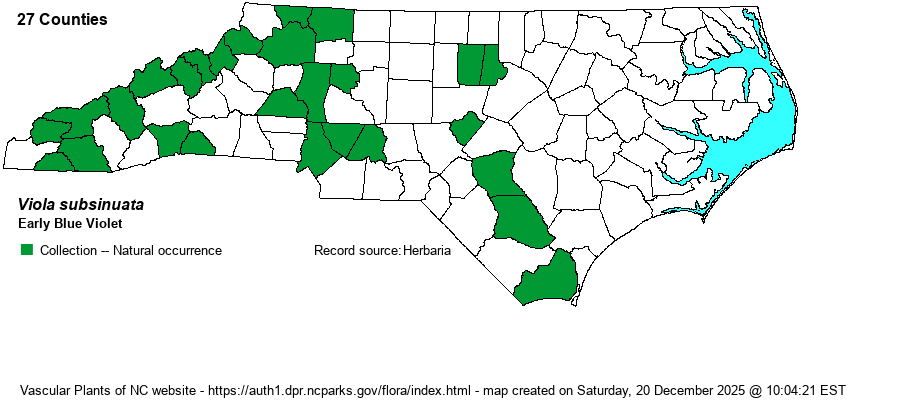| Author | Greene | |
| Distribution | Scattered over the Mountains and much of the Piedmont, with gaps; details to be worked out. Also inner Coastal Plain, where rare. Specimens are essentially old ones that were collected with the assumption at the time that they were V. palmata. Our map reflects annotated specimns at NCU verified by Ballard in July 2024 and at SERNEC by Sorrie in Sept. 2024.
This is a Northern species, ranging from VT and MI, south to GA, AL, and MS, according to Weakley (2018). | |
| Abundance | Uncertain, but poorly known. Based on the range map, it likely is fairly common in the Mountains, and uncommon in the Piedmont, and rare toward the Coastal Plain. The website editors suggest a State Rank of S3? | |
| Habitat | Weakley (2018) states that the habitats are: "Rich, dry-mesic and dry upland forests, probably associated with mafic rocks." If true, then it likely would be uncommon if not also somewhat local in the Piedmont, where such mafic rocks are infrequent, especially as compared with the Mountains. | |
| Phenology | Blooms from April to May, and fruits soon after flowering. | |
| Identification | This spedies is very similar to V. palmata and V. edulis, in that it has separate leaves and flowering stalks (i.e., is acaulescent), with violet-blue flowers. In this species, all leaves are dissected into 3 or more segments/lobes, including the earliest ones; many leaves have 9 or more lobes, though the middle is almost always the widest. In the other two species, the earliest leaves are undivided -- ovate to heart-shaped. This seems to be the sole key defining character for the species, and thus if you see a violet with all leaves divided, but no undivided ones, it should be this species. However, can individuals of V. edulis and/or V. palmata be found that have had the early, undivided leaves withered and no longer visible? Thankfully for the biologist, V. edulis is a Coastal Plain species and is limited to wetlands, not an identification concern; thus, the trick is to make sure that V. palmata -- also found in dry or mesic upland forests of the Mountains and Piedmont -- is completely eliminated from consideration. | |
| Taxonomic Comments | Some references do not consider this as a valid species, but NatureServe and Weakley (2018) do. Very few of the older references mention this species; it presumably was included within V. palmata by them. Weakley (2022) now adds an undescribed variant -- the "Chapel Hill" one; the website editors choose not to add accounts for most undescribed Viola variants owing to highly unsettled taxonomy.
General note on Viola: In 2009-10 B.A. Sorrie (website map editor) went through the whole collection at NCU, annotating all specimens against those verified by experts in the genus. The range maps in RAB (1968) have been changed accordingly. More recently, Harvey Ballard and colleagues are in the process of revising all Eastern and Southeastern Viola, and have annotated all specimens at NCU in July 2024. They recognize additional species not in RAB or in previous editions of Weakley et al.; we will follow updated editions of Weakley et al. in recognizing them. Species range maps have been adjusted to account for identification changes. | |
| Other Common Name(s) | Wavyleaf Violet | |
| State Rank | [S3?] | |
| Global Rank | G3G5 | |
| State Status | | |
| US Status | | |
| USACE-agcp | FACU link |
| USACE-emp | FACU link |

